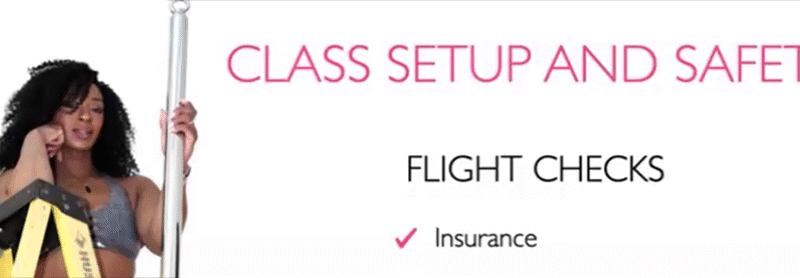A train-cation is a trip (usually away from home) where you focus for a specific…

Does Your Pole Event Have an Emergency Action Plan?
Pole dance events can include pole competitions, showcases, or gigs. Although the risk is rare, emergencies and injuries can and will happen at pole dance events.
Is your pole dance event prepared for those risks? Do you have a plan of action?
Read this post to help you and the staff of your pole event plan and prepare for emergencies.
What is an emergency action plan?
Emergency action plans are written procedures to deal with emergent situations specific to the location of your pole event. Creating an emergency action plan is a good practice in identifying the emergencies that are most likely to occur both within the event (example: performer injury) or at your event’s location (example: fire or tornado). The emergency action plan is unique to your pole event and its location. While you certainly cannot plan for every possible scenario, events that have written and trained their staff on emergency action plans can significantly improve the effectiveness of response to emergencies.
Considerations for a Pole Dance Event
Pole dance events are often held in venues, such as hotels or convention centers. These venues will likely already have an emergency action plan in place. In these cases, you should work with the venue to become familiar and ensure compliance with their emergency action plan. You should also make sure the venue is aware and ready for any additional plans you have specific to your event within their venue.
Plan to have medics (ie, athletic trainers, EMTs, etc.) on-site to provide medical coverage for your pole event. They can be a helpful resource for the drafting of your emergency action plan. If they are not involved in planning, when you meet them on-site make sure they are aware of the emergency action plan and location of emergency equipment.
Essentials of the Emergency Action Plan
At the minimum, the essential items of an emergency action plan include the following:
- Emergency personnel. Who is responsible for activating the emergency action plan? This is likely the event owner and/or staff members (if event owner is not on site).
- Emergency communication. Examples are contacting medics on site, dialing 911, or pulling the fire alarm.
- Evacuation procedures and emergency escape routes. This includes how to exit the pole event should an emergency occur. Diagrams that detail the escape routes are helpful. Venues should already have these, so make sure you and your staff are aware. Staff must be trained so that they may guide participants and attendees appropriately.
- Accounting for participants and attendees when an emergency has occurred. Does the venue have an alarm system? If not, someone should be responsible for ensuring all are notified of the situation.
- Notifying medics on-site and/or EMS. This part of the plan involves when to call the medics on-site or EMS and who is responsible for doing so. It is important to have details ready for EMS (address and contact info of the event, special directions or instructions for accessing the event, especially if the event is located within a larger venue).
- Follow-up procedures. After an injury or emergency occurs, it is crucial to document the occurrence for legal purposes. Having an already-established injury report document on hand is helpful for staff.
Other items to consider adding into the emergency action plan include:
- Location of emergency contacts for participants in the pole event. This could be placed in the liability waiver for the event or in their registration form.
- Emergency equipment. Do you have an AED on site? Do the medics who are providing medical coverage have an AED and other emergency equipment on hand? If your pole event is located within a hotel or convention center, the venue will likely have an AED in a visible and accessible location. Make sure you and your staff know how to access and use the AED.
- Multiple event locations. If you have more than one event location (for example, multiple rooms or locations at a pole convention), the emergency action plan must be written specific to each location.
For more information, OSHA has a helpful tool to walk business owners through drafting and implementing emergency action plans.
Updating the Emergency Action Plan
Remember that the EAP is a working document, meaning that it should be reviewed and revised accordingly. At a minimum, it should be reviewed and updated annually. Make sure to include a revision date to keep track of when it was last reviewed. It should also be reviewed following an emergency. This ensures that procedures were followed and helps to identify areas in the plan that could be improved.
Training Staff on the Emergency Action Plan
The emergency action plan must be reviewed and rehearsed with your staff. The onboarding of each new staff member should include familiarization of the emergency action plan. It is good practice to rehearse the emergency action plan bi-annually or annually with the entire staff.
How does the Liability Waiver relate to the Emergency Action Plan?
Make sure participants read and sign a liability waiver. Liability waivers attempt to release responsibility from the event to a participant when injuries occur. It is a good idea to have the participant provide an emergency contact on the liability waiver. File and organize the waivers in a way that they are readily accessible. This is important if you need to quickly access a participant’s contact in an emergency situation.
Conclusion
In conclusion, assess the risks that may be associated with your pole dance event and its location. Write an emergency action plan specific to each location that is a part of your pole event. Make sure staff members have read, understood, and rehearsed the emergency action plan. Review your liability waiver to ensure it has an emergency contact section that can be easily accessible in an emergent situation. Update the emergency action plan annually.
While it is not possible to account for every emergent situation, having an emergency action plan in place can significantly reduce risk of injury and legal action at your studio.
If you need guidance with your emergency action plan for your pole dance event, reach out to IPIA member and athletic trainer Dr. Jenny Hunnicutt at info@drjennypoles.com.



